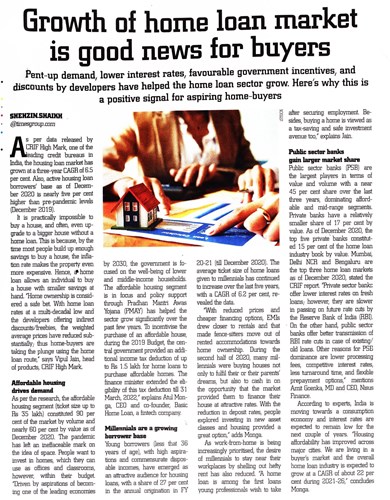Growth of home loan market is good news for buyers
Pent-up demand, lower interest rates, favourable government incentives, and discounts by developers have helped the home loan sector grow. Here’s why this is a positive signal for aspiring home-buyers
As per data released by CRIF High Mark, one of the leading credit bureaus in India, the housing loan market has grown at a three-year CAGR of 6.5 per cent Also, active housing loan borrowers' base as of December 2020 is nearly five per cent higher than pre-pandemic levels (December 2019). It is practically impossible to buy a house, and often, even upgrade to a bigger house without a home loan. This is because, by the time most people build up enough savings to buy a house, the inflation rate makes the property even more expensive. Hence, a home loan allows an individual to buy a house with smaller savings at hand. “Home ownership is considered a safe bet. With home loan rates at a multi-decadal low and the developers offering indirect discounts/freebies, the weighted average prices have reduced substantially, thus home-buyers are taking the plunge using the home loan route," says Vipul Jain, head of products, CRIF High Mark.
Affordable housing drives demand
As per the research, the affordable housing segment (ticket size up to Rs 35 lakh) constituted 90 per cent of the market by volume and nearly 60 per cent by value as of December 2020. The pandemic has left an ineffaceable mark on the idea of space. People want to invest in homes, which they can use as offices and classrooms, however, within their budget. "Driven by aspirations of becoming one of the leading economies by 2030, the government is focused on the well-being of lower and middle-income households. The affordable housing segment is in focus and policy support through Pradhan Mantri Awas Yojana (PMAY) has helped the sector grow significantly over the past few years. To incentivize the purchase of an affordable house, during the 2019 Budget, the central government provided an additional income tax deduction of up to Rs 1.5 lakh for home loans to purchase affordable homes. The finance minister extended the eligibility of this tax deduction till 31 March 2022," explains Atul Manga, CEO and co-founder, Basic Home Loan, a fintech company.
Millennials are a growing borrower base
Young borrowers (less than 36 years of age), with high aspirations and commensurate disposable incomes, have emerged as an attractive audience for housing loans, with a share of 27 per cent in the annual origination in FY 20-21 (till December 2020). The average ticket size of home loans given to millennials has continued to increase over the last five years, with a CAGR of 6.2 per cent, revealed the data. "With reduced prices and cheaper financing options, EMIs drew closer to rentals and that made fence-sitters move out of rented accommodations towards home ownership. During the second half of 2020, many millennials were buying houses not only to fulfil their or their parents' dreams, but also to cash in on the opportunity that the market provided them to finance their house at attractive rates. With the reduction in deposit rates, people explored investing in new asset classes and housing provided a great option," adds Monga. As work-from-home is being increasingly prioritized, the desire of millennials to stay near their workplaces by shelling out hefty rent has also reduced. 'A home loan is among the first loans young professionals wish to take after securing employment. Besides, buying a home is viewed as a tax-saving and safe investment avenue too," explains Jain.
Public sector banks gain larger market share
Public sector banks (PSB) are the largest players in terms of value and volume with a near 45 per cent share over the last three years, dominating affordable and mid-range segments. Private banks have a relatively smaller share of 17 per cent by value. As of December 2020, the top five private banks constituted 15 per cent of the home loan industry book by value. Mumbai, Delhi NCR and Bengaluru are the top three home loan markets as of December 2020, stated the CRIF report. "Private sector banks offer lower interest rates on fresh loans; however, they are slower in passing on future rate cuts by the Reserve Bank of India (RBI). On the other hand, public sector banks offer better transmission of RBI rate cuts in case of existing/ old loans. Other reasons for PSE dominance are lower processing fees, competitive interest rates, less turnaround time, and flexible prepayment options," mentions Amit Goenka, MD and CEO, Nisus Finance.
According to experts, India is moving towards a consumption economy and interest rates are expected to remain low for the next couple of years. "Housing affordability has improved across major cities. We are living in a buyer's market and the overall home loan industry is expected to grow at a CAGR of about 22 per cent during 2021 -26," concludes Monga.
Source: Publication: The Times of India,16th July,2021

